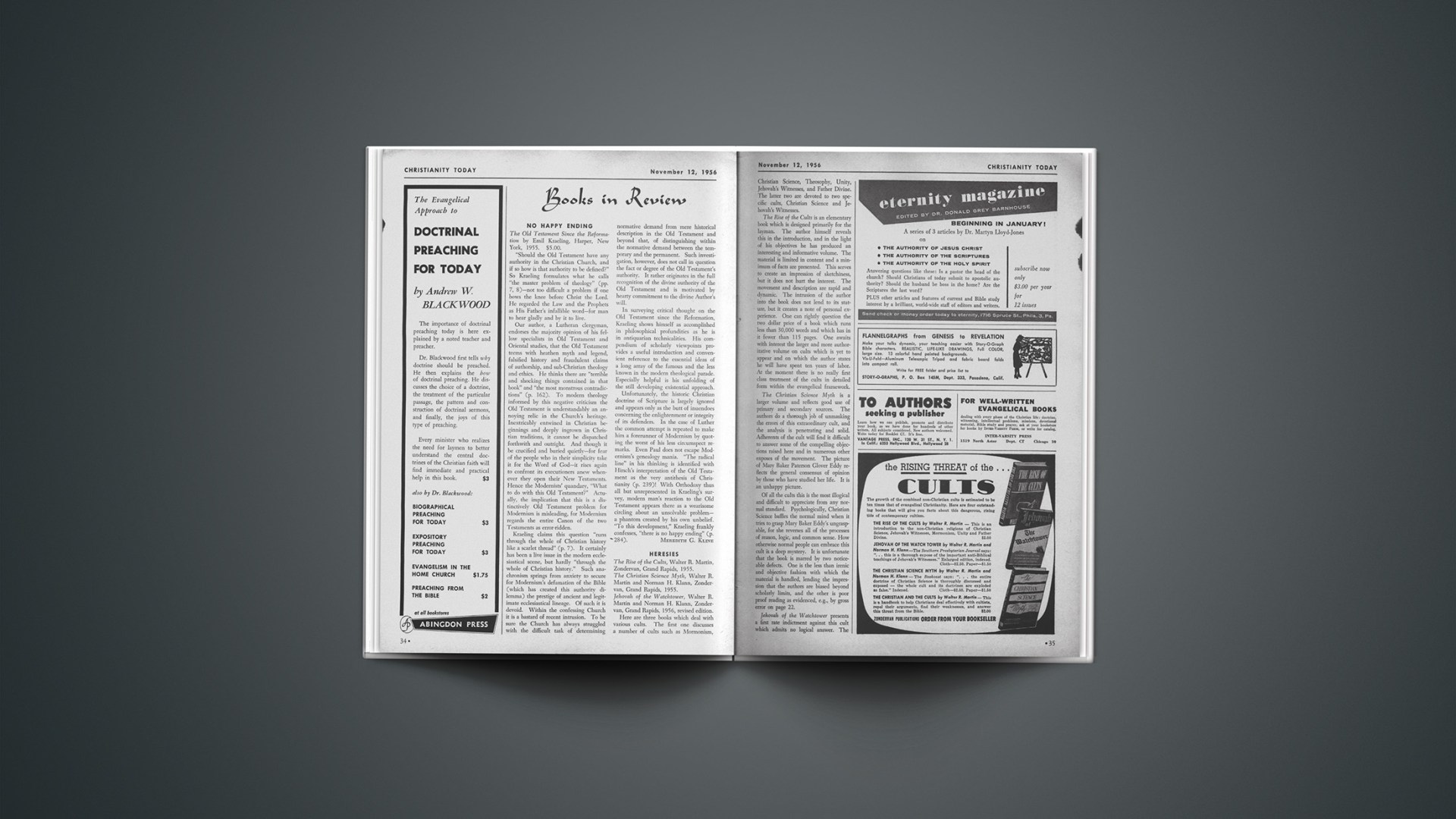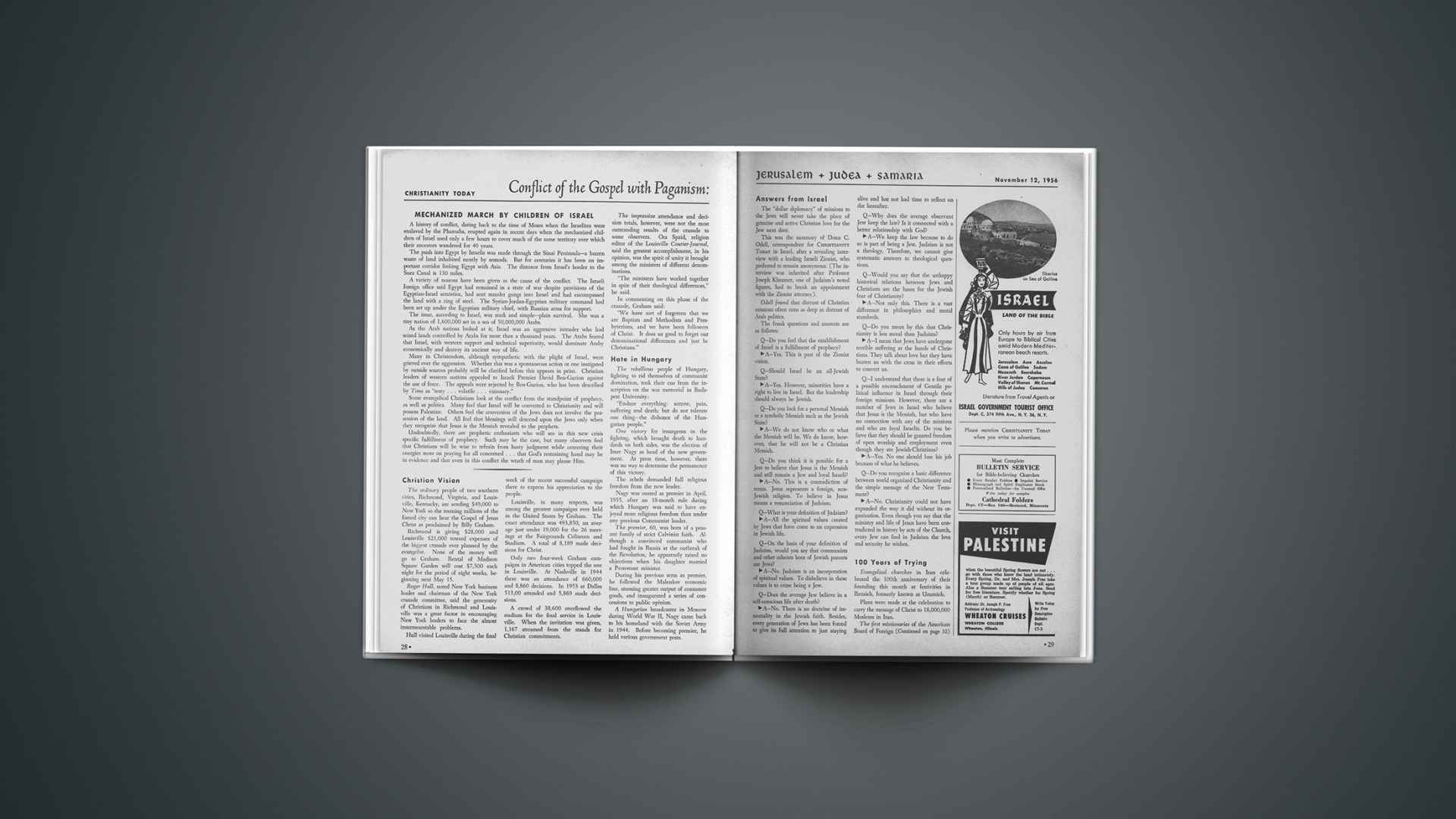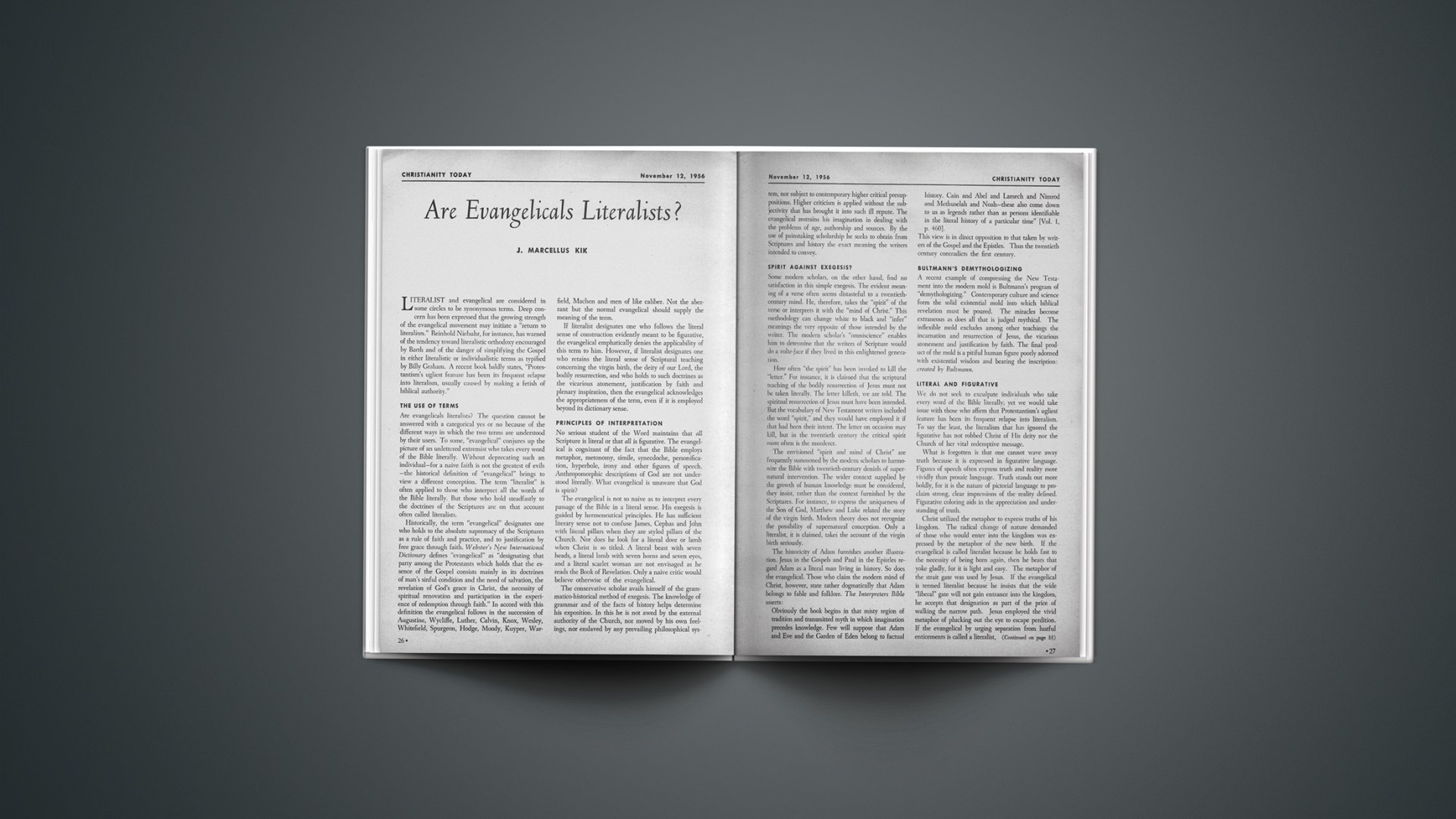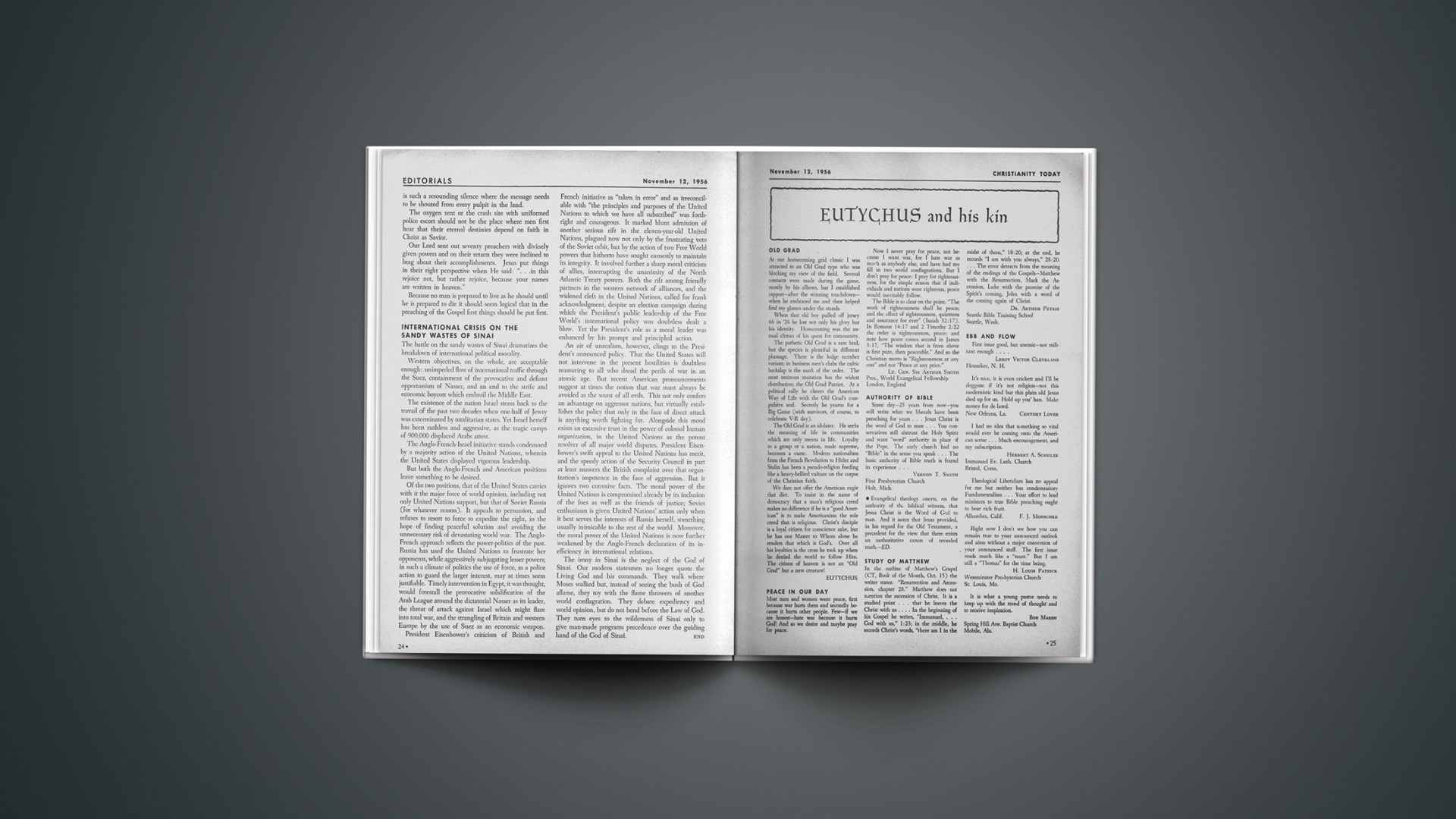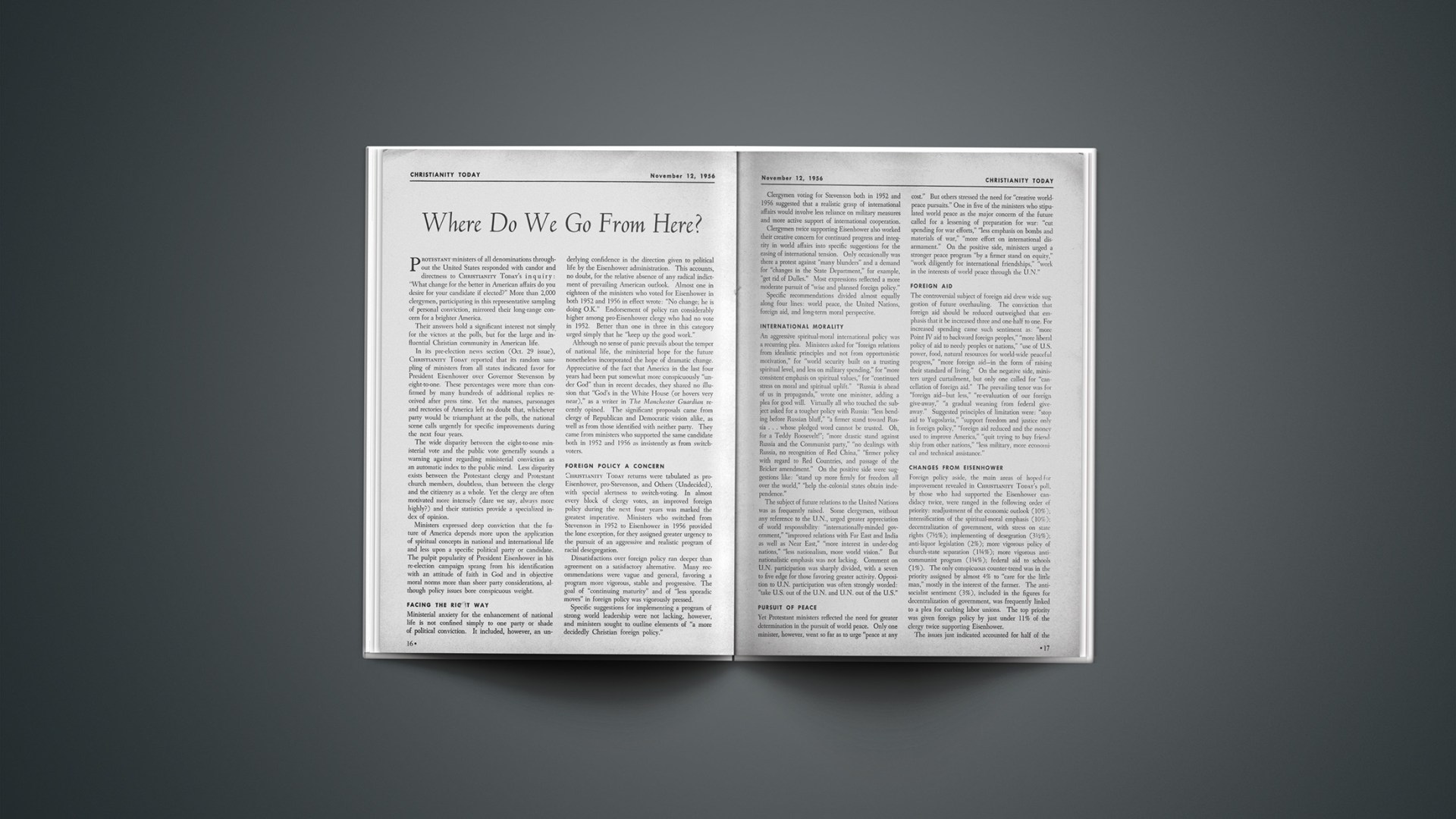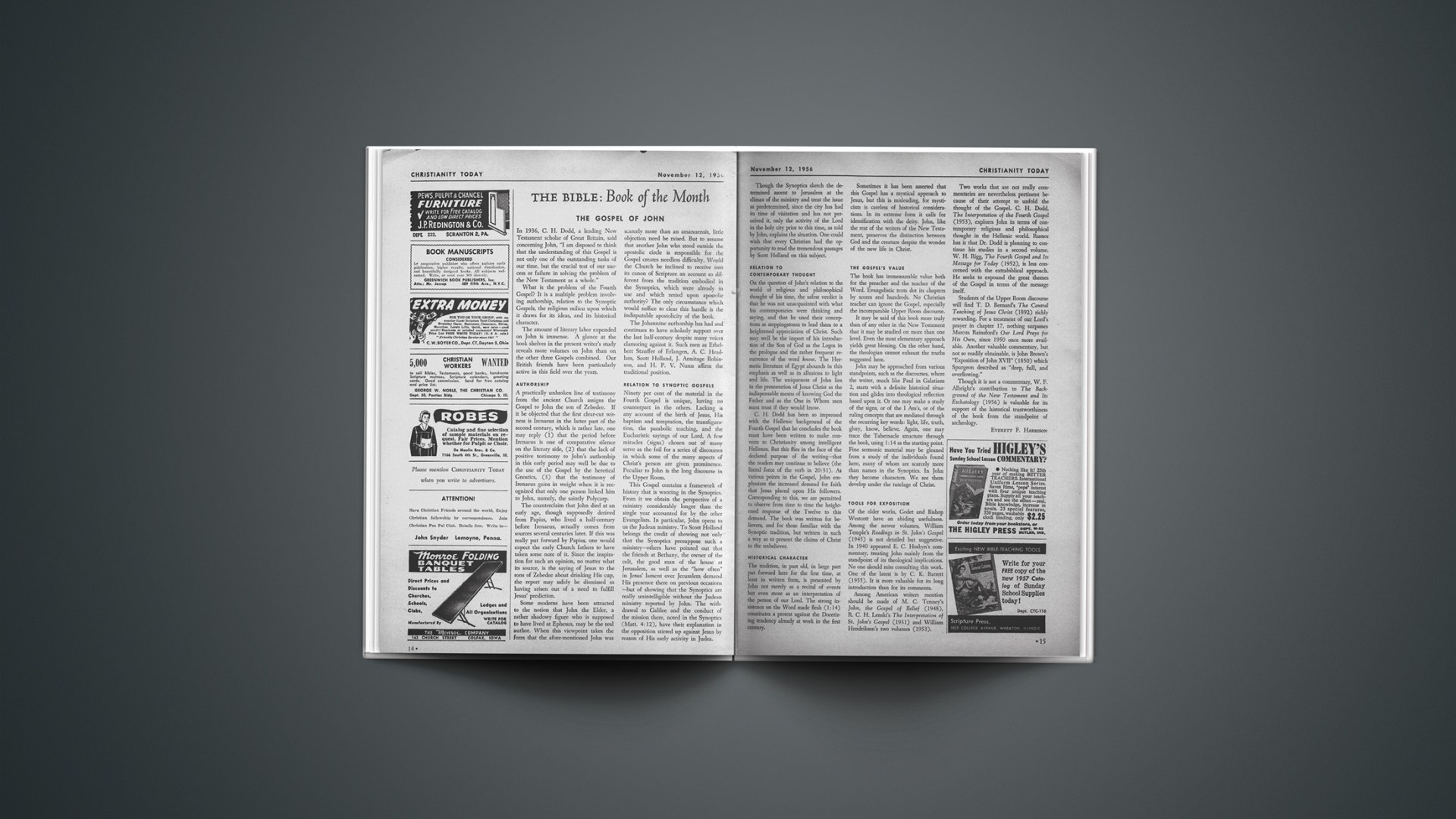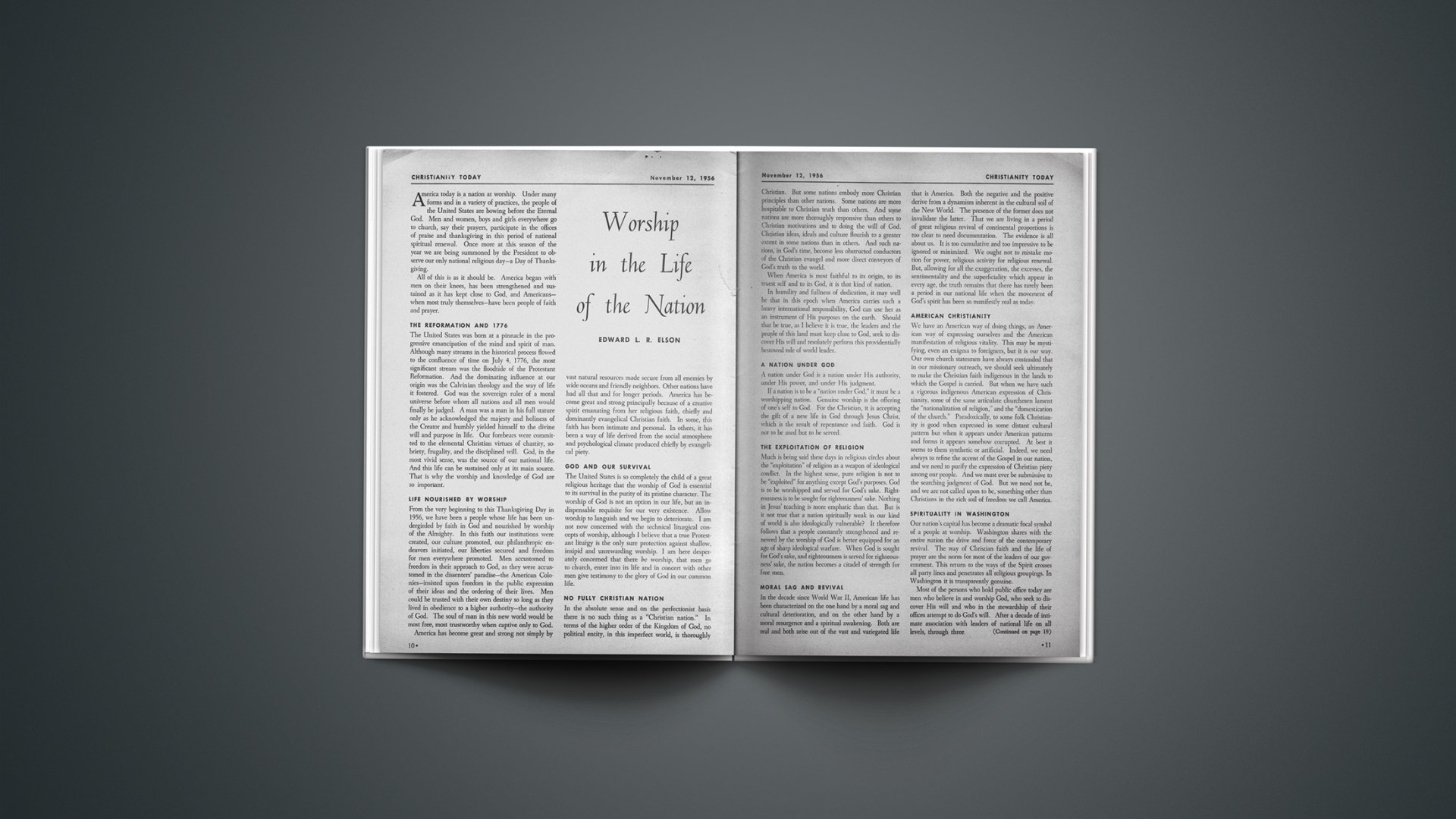No Happy Ending
The Old Testament Since the Reformation by Emil Kraeling, Harper, New York, 1955. $5.00.
“Should the Old Testament have any authority in the Christian Church, and if so how is that authority to be defined?” So Kraeling formulates what he calls “the master problem of theology” (pp. 7, 8)—not too difficult a problem if one bows the knee before Christ the Lord. He regarded the Law and the Prophets as His Father’s infallible word—for man to hear gladly and by it to live.
Our author, a Lutheran clergyman, endorses the majority opinion of his fellow specialists in Old Testament and Oriental studies, that the Old Testament teems with heathen myth and legend, falsified history and fraudulent claims of authorship, and sub-Christian theology and ethics. He thinks there are “terrible and shocking things contained in that book” and “the most monstrous contradictions” (p. 162). To modern theology informed by this negative criticism the Old Testament is understandably an annoying relic in the Church’s heritage. Inextricably entwined in Christian beginnings and deeply ingrown in Christian traditions, it cannot be dispatched forthwith and outright. And though it be crucified and buried quietly—for fear of the people who in their simplicity take it for the Word of God—it rises again to confront its executioners anew whenever they open their New Testaments. Hence the Modernists’ quandary, “What to do with this Old Testament?” Actually, the implication that this is a distinctively Old Testament problem for Modernism is misleading, for Modernism regards the entire Canon of the two Testaments as error-ridden.
Kraeling claims this question “runs through the whole of Christian history like a scarlet thread” (p·7). It certainly has been a live issue in the modern ecclesiastical scene, but hardly “through the whole of Christian history.” Such anachronism springs from anxiety to secure for Modernism’s defamation of the Bible (which has created this authority dilemma) the prestige of ancient and legitimate ecclesiastical lineage. Of such it is devoid. Within the confessing Church it is a bastard of recent intrusion. To be sure the Church has always struggled with the difficult task of determining normative demand from mere historical description in the Old Testament and beyond that, of distinguishing within the normative demand between the temporary and the permanent. Such investigation, however, does not call in question the fact or degree of the Old Testament’s authority. It rather originates in the full recognition of the divine authority of the Old Testament and is motivated by hearty commitment to the divine Author’s will.
In surveying critical thought on the Old Testament since the Reformation, Kraeling shows himself as accomplished in philosophical profundities as he is in antiquarian technicalities. His compendium of scholarly viewpoints provides a useful introduction and convenient reference to the essential ideas of a long array of the famous and the less known in the modern theological parade. Especially helpful is his unfolding of the still developing existential approach.
Unfortunately, the historic Christian doctrine of Scripture is largely ignored and appears only as the butt of inuendoes concerning the enlightenment or integrity of its defenders. In the case of Luther the common attempt is repeated to make him a forerunner of Modernism by quoting the worst of his less circumspect remarks. Even Paul does not escape Modernism’s genealogy mania. “The radical line” in his thinking is identified with Hirsch’s interpretation of the Old Testament as the very antithesis of Christianity (p. 239)! With Orthodoxy thus all but unrepresented in Kraeling’s survey, modern man’s reaction to the Old Testament appears there as a wearisome circling about an unsolvable problem—a phantom created by his own unbelief. “To this development,” Kraeling frankly confesses, “there is no happy ending” (p. 284).
MEREDITH G. KLINE
Heresies
The Rise of the Cults, Walter R. Martin, Zondervan, Grand Rapids, 1955.
The Christian Science Myth, Walter R. Martin and Norman H. Klann, Zondervan, Grand Rapids, 1955.
Jehovah of the Watchtower, Walter R. Martin and Norman H. Klann, Zondervan, Grand Rapids, 1956, revised edition.
Here are three books which deal with various cults. The first one discusses a number of cults such as Mormonism, Christian Science, Theosophy, Unity, Jehovah’s Witnesses, and Father Divine. The latter two are devoted to two specific cults, Christian Science and Jehovah’s Witnesses.
The Rise of the Cults is an elementary book which is designed primarily for the layman. The author himself reveals this in the introduction, and in the light of his objectives he has produced an interesting and informative volume. The material is limited in content and a minimum of facts are presented. This serves to create an impression of sketchiness, but it does not hurt the interest. The movement and description are rapid and dynamic. The intrusion of the author into the book does not lend to its stature, but it creates a note of personal experience. One can rightly question the two dollar price of a book which runs less than 30,000 words and which has in it fewer than 115 pages. One awaits with interest the larger and more authoritative volume on cults which is yet to appear and on which the author states he will have spent ten years of labor. At the moment there is no really first class treatment of the cults in detailed form within the evangelical framework.
The Christian Science Myth is a larger volume and reflects good use of primary and secondary sources. The authors do a thorough job of unmasking the errors of this extraordinary cult, and the analysis is penetrating and solid. Adherents of the cult will find it difficult to answer some of the compelling objections raised here and in numerous other exposes of the movement. The picture of Mary Baker Paterson Glover Eddy reflects the general consensus of opinion by those who have studied her life. It is an unhappy picture.
Of all the cults this is the most illogical and difficult to appreciate from any normal standard. Psychologically, Christian Science baffles the normal mind when it tries to grasp Mary Baker Eddy’s ungraspable, for she reverses all of the processes of reason, logic, and common sense. How otherwise normal people can embrace this cult is a deep mystery. It is unfortunate that the book is marred by two noticeable defects. One is the less than irenic and objective fashion with which the material is handled, lending the impression that the authors are biased beyond scholarly limits, and the other is poor proof reading as evidenced, e.g., by gross error on page 22.
Jehovah of the Watchtower presents a first rate indictment against this cult which admits no logical answer. The authors did justice in delineating the leading figures of the cult and indeed, could have added additional information of a more damaging nature. The analysis of the leading deficiencies of the cult over against the historic Christian faith is excellent, and the examination of key passages of the Bible which are distorted beyond recognition by Jehovah’s Witnesses strikes a telling blow.
One of the most difficult jobs—and it has not yet been done—is that of discovering the true reasons why people embrace this or other cults. The authors do offer suggestions which are helpful, but an outstanding contribution could be made to the field of study by a Christian psychiatrist who has the biblical background and the scientific training.
The authors are to be commended for undertaking a difficult job and for creating what is the beginning of a substantial apologetic against these heresies. We can look hopefully for further additions to the literature about the cults in the days ahead.
HAROLD LINDSELL
Realized Eschatology
Many Things in Parables, by Ronald S. Wallace, Harper, New York, $3.00.
This is a book of stimulating sermons on the parables of Christ. If the reader can manage to make due allowances for the author’s eschatological viewpoint, he will find page after page of fresh, arresting and pertinent observations.
The language is strongly evangelical and delightfully Christ-centered. But as most of the parables of our Lord abound in eschatological references, the reader of this book cannot help but notice that the author’s application is all too often without any other-worldly frame of reference.
Mr. Wallace, who is a minister of the Church of Scotland, clearly belongs to the school of C. H. Dodd and others, which is “realized eschatology.” However, according to Mr. Wallace, his is a “modified” form of realized eschatology. He acknowledges the prophetic element in the parables, interpreting it futuristically in the sense that it is taken to apply to “the present extension of the eschatological tension.” In other words, Wallace sees in the parables not only a contemporary application for the Lord’s day, but a continuing one for our own day.
But this variation upon the theme of realized eschatology in no wise frees Mr. Wallace from a view of history and eschatology which is essentially the religious equivalent of existentialism. To the extent that Wallace modifies C. H. Dodd, it is only in that “the whole sphere of the world today is being disturbed by Jesus Christ,” as was His own day—and this is the fulfillment of the prophetic element in the parables.
Thus in connection with the parable of the Pounds, we read that Christ has “gone to be in heaven” and now “sits at the right hand of God, controlling all things and awaiting the good pleasure of the Father till He shall return.” But, at the same time, the day of reckoning takes place whenever “Jesus comes to face men and reckon with them about their lives.” Then it is that “the truth about men’s attitude to the Lord comes out,” and “men begin to read their own hearts aright in the presence of Christ.”
Again, one reads appreciatively of the “living” Christ to our day until one suddenly discovers what Mr. Wallace means by “living.” He means that Christ must become as real to each of us as though we were among those who actually knew Him when He was living. In other words, for us to “take the living Christ into our lives” means that we must project ourselves backwards 2,000 years and walk with Him there. This, to me, is a new one.
This book vividly illustrates the danger facing historic Christianity today in the form of those modern theologies which blandly appropriate all of the thought-forms and phrases of Scripture but with an interpretation which makes eschatology into an ideal, history into poetry, and the other-worldly frame of reference only an attitude of the mind and heart. The untrained seeker after truth falls flat on his face before he realizes the ground has dropped from under him.
G. AIKEN TAYLOR
Luke Paraphrased
St. Luke’s Life of Jesus, by G. Aiken Taylor, Macmillan, New York, $2.75.
A translation has to do with the transfer of the exact thought expressed in one language into another. A paraphrase is a restatement of a text giving the meaning in another form, usually for clearer and fuller exposition. It is more a free rendering than a translation. The volume under review must be categorized as a paraphrase rather than a new translation. Dr. Taylor has gone to the original Greek to express Luke’s meaning in each verse, but has exercised considerable latitude in order to be more intelligible to the reader. His purpose has been to retell the gospel narrative in the language of our day. The author writes, “I offer this story I think Luke told. Taken from his writings only, it is a modern version of what I believe he wanted to convey through his story of Jesus Christ.” Again he states, “Mine is not primarily the story of what Jesus said and did, but what Luke intended to say about what Jesus said and did.”
The first section is called, “The Prelude.” The paraphrase reads as follows:
Thus, Theophilus, the Lord came; no stranger, not secretly, but with His credentials openly in His hand and unmistakable from the very beginning. As a matter of fact, they knew He would be someone special before the beginning as men count time. Wherever God’s invasion of Time through the miracle of the Incarnation touched the human sphere, those who stood at the points of contact knew they had been touched. We say this because among us today live those who felt it. Make no mistake: no mere man walked Galilee’s rolling hills and died on Judea’s barren Place of the Skull. He who did so bore in Himself that radiance the pale reflection of which shines from each human heart lately brought to Life by a Power greater than itself.
It is safe to say that for years to come this volume will be helpful to all who desire to appropriate more fully the Gospel as recorded by Luke. This lucid and penetrating presentation of the person, life, ministry and words of Christ is needed today and into the end of time. It should prove suggestive to ministers, Bible students and laymen. No thoughtful reader will leave this book without a deep and rich Christian experience.
JOHN R. RICHARDSON
Without Footnotes
Ecclesiastical History, by Eusebius, Baker, Grand Rapids, Mich., 1956.
This is a reprint of a great classic. No one familiar with the field need be told anything about the significance of this early church history which has come down to us.
Anyone interested in the history of the early church must sooner or later have recourse to Eusebius. It is an extraordinary document and contains much important information about the progress of the Christian faith. Persecutions, heresies, leading ecclesiastical figures all find their way into the pages of the volume. Contained therein is a mine of useful information about the life and times of Constantine.
The most serious defect of this popular edition is not what it does but what it fails to do. It lacks the notes which one can find in the Second Series of the Nicene and Post-Nicene Fathers which appeared under the editorial supervision of Schaff and Wace. The profusion of notes is precisely what makes this other edition so valuable. These notes are lacking in the popular edition which is limited to the Eusebian text. And the text without the footnotes is far less valuable.
HAROLD LINDSELL
Salient Mission Facts
A Survey of World Missions, by John Caldwell Thiessen, Inter-Varsity Press, Chicago 10. $5.95.
It is one thing to lament the existing gaps in various fields of evangelical literature; it is quite another to do something about it, and not many choose this latter alternative. The author of this work, the Professor of Missions at the Detroit Bible Institute, was deeply concerned about the lack of an up-to-date text book on the growth of the missionary enterprise, and he set himself to remedy the situation.
The result of his labors, and they must have been prodigious ones, is seen in A Survey of World Missions. Prefacing his consideration of present-day conditions by a brief treatment of the missionary movement through the ages, Mr. Thiessen goes on to consider the salient facts concerning the present-day situation in all the nations to which the Gospel has been taken.
He accomplishes his purpose by dividing the world into major areas, then considering each country within a given area as to the land, the people, and the religious situation. This is followed by a treatment of the political history and the missionary history of each nation. In each major section a chart is given, offering a comparative presentation of the more significant facts concerning the countries within the area.
In his description of the missionary history of the various lands, the author has endeavored to be scrupulously fair and inclusive in his treatment of the various missionary organizations that have labored in them.
It all adds up to a tremendous piece of work, which makes a real and much-needed contribution to the field of evangelical literature. Nowhere else is this material available in such accessible form, and it would seem incontrovertible that this book would be much desired, and much used by any missionary-minded pastor; or by any layman who is concerned for the fulfillment of the Great Commission.
Because of the scope of the work, and the obvious necessity of making use of secondary sources, it is inevitable that there should be deficiencies in such a book. There are minor errors of fact, which will probably be remedied in a later edition. By choosing to make his survey nation by nation, the author is unable in any one place to treat major factors which influence the current situation in large areas of the earth. It is possible, for example, to read the whole section on Latin America without getting anything like an adequate picture of the effects of the amazing population expansion and the rise of nationalism on the missionary enterprise there. The proportion of space given to some organizations over against others is debatable, to say the least, and the occasional mention of the missionary work of the various sects is not adequate to convey their tremendous influence on some mission fields. The subject of evangelical literature does not seem to get the prominence it merits.
While these criticisms are significant enough to mention, they should not be allowed to obscure the great value of Mr. Thiessen’s work. He has remedied a serious situation in the realm of missionary literature. There will be many who find not only helpful information and a stimulus to intercession, but cause for thanksgiving in the pages of this book. It represents a difficult task well done.
H. L. FENTON, JR.
Distaff Side
How to be a Preacher’s Wife and Like it, by Lora Lee Parrot, Zondervan, Grand Rapids, Michigan, $2.00
Here is a volume which can be read with profit. Mrs. Parrot has prepared a thorough and well-organized manual for the minister’s wife, based upon broad experience as daughter and then wife of a minister.
She gives practical hints on efficient and economical home management which would be helpful to anyone on a limited budget. But even more valuable are her discussions concerning problems peculiar to ministers’ wives. She analyzes reasons for criticism and ways to deal with it. Procedures to overcome nervous exhaustion are suggested. She is excellent on the subject of the parsonage, including the parsonage telephone and church-owned furniture! She discusses appropriate dress for the minister and his wife.
While some of the material is admittedly based upon Mrs. Parrot’s personal preferences or prejudices, the great bulk is based upon sound principles of psychology and domestic science and all in accord with scriptural attitudes.
NORMA R. ELLIS

